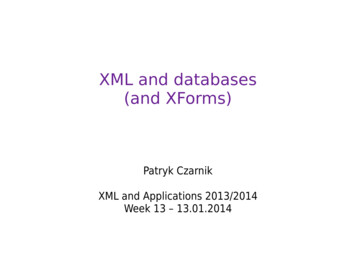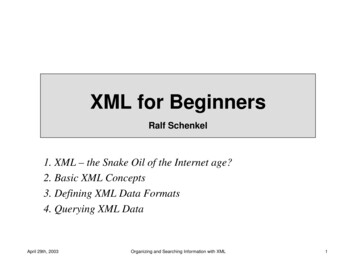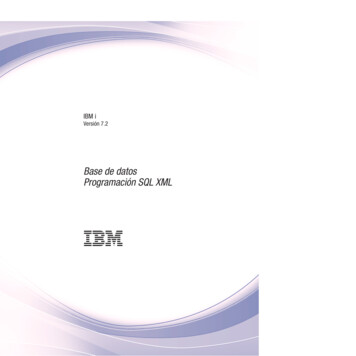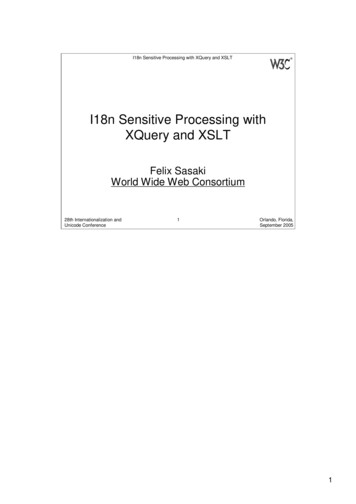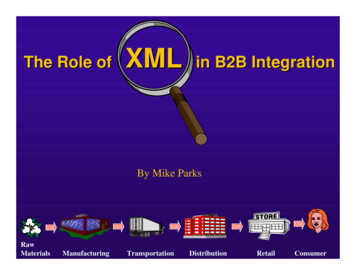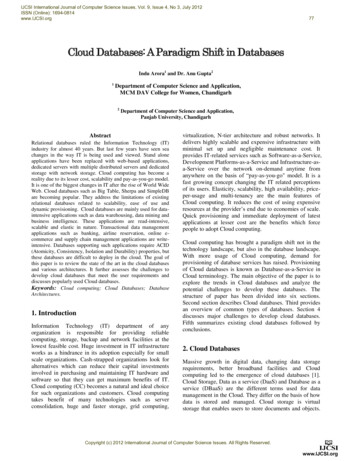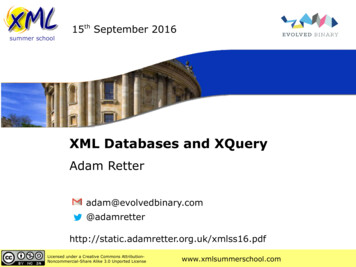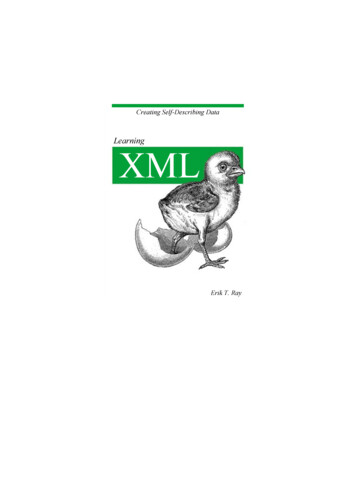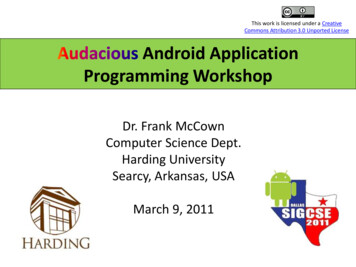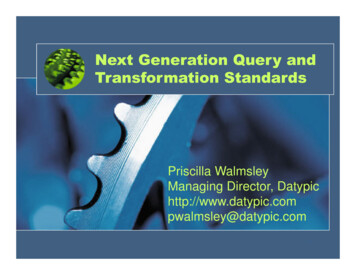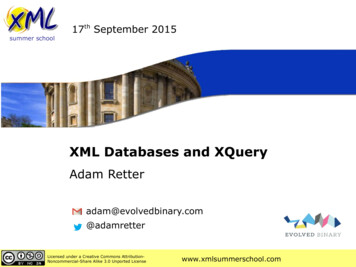
Transcription
summer school17th September 2015XML Databases and XQueryAdam Retteradam@evolvedbinary.com@adamretterLicensed under a Creative Commons AttributionNoncommercial-Share Alike 3.0 Unported Licensewww.xmlsummerschool.com
Who are you?summer school Programmer / Consultant– XQuery / XSLT– Scala / Java– Concurrency Core contributor to eXist XML Database Contributor to Facebook's RocksDB W3C XQuery WG Invited expert www.adamretter.org.ukLicensed under a Creative CommonsAttribution-Noncommercial-Share Alike 3.0 Unported Licensewww.xmlsummerschool.comSlide 2
Learning Objectivessummer schoolThis class looks at XML Databases and XQuery. Wewill use the eXist XML Database to demonstrate WebApplication programming in XQuery.1. Understand what an XML Database is2. Understand how an XML Database works3. Introduction to XQuery4. Learn the basics of XQuery5. Test your knowledge6. Practice by building a Simple XQuery App7. Review and Improve the AppLicensed under a Creative CommonsAttribution-Noncommercial-Share Alike 3.0 Unported Licensewww.xmlsummerschool.comSlide 3
Contentssummer schoolLecture ( 90 Minutes)1. What is an XML Database?2. How does an XML Database work? (advanced)3. Introduction to XQuery4. XQuery Basics(: Break (30 Minutes) :)Tutorial Session ( 90 Minutes)5. Advanced XQuery6. XML Applications7. Building an XML Application8. Web Enabling an XML Application9. Hands-on. Adding features to the XML ApplicationLicensed under a Creative CommonsAttribution-Noncommercial-Share Alike 3.0 Unported Licensewww.xmlsummerschool.comSlide 4
summer schoolIntroduction to XMLDatabasesLicensed under a Creative Commons AttributionNoncommercial-Share Alike 3.0 Unported Licensewww.xmlsummerschool.com
Why Native XML Database?summer school Why a database, why not use a File System?–How to retrieve? By file-path or some sort of lookup table?i.e. Is a 'Directory' the same as a 'Collection'?–Where to keep metadata?–How to Query? –grep?Integrate a search-engine (full-text), e.g. Apache Solr?No direct XPath access!How to Update?Licensed under a Creative CommonsAttribution-Noncommercial-Share Alike 3.0 Unported Licensewww.xmlsummerschool.comSlide 6
What is an XML Database?summer school More than just a filesystem! Unit of storage is the Document It ingests (and may return) XML documents Node aware, e.g. cross and in document access CRUD operations on document(s)/node(s) Some form of query facility/languageLicensed under a Creative CommonsAttribution-Noncommercial-Share Alike 3.0 Unported Licensewww.xmlsummerschool.comSlide 7
What is an XML Database?summer school Full-Text capabilities Indexes defined for document queries May support non-XML content– e.g. Key/Value, Tabular, JSON, Binary, Graph etc. Single or Multi-user: Client/Server and/or EmbeddedLicensed under a Creative CommonsAttribution-Noncommercial-Share Alike 3.0 Unported Licensewww.xmlsummerschool.comSlide 8
What is an XML Database?summer school“An XML database is a data persistence software system thatallows data to be specified, and sometimes stored, in XML format.These data can then be queried, transformed, exported andreturned to a calling system. XML databases are a flavor ofdocument-oriented databases which are in turn a category ofNoSQL database (meaning Not (only) SQL).”-- https://en.wikipedia.org/wiki/XML databaseLicensed under a Creative CommonsAttribution-Noncommercial-Share Alike 3.0 Unported Licensewww.xmlsummerschool.comSlide 9
Types of XML Databasesummer school XML Enabled Database– Existing database product which added support for XML– Predominant Data Model and purpose is NOT XML– Heterogenous data models Typically used when only small amounts of XML areinvolved Native XML Database (NXDB)– Designed for XML storage/retrieval/query from the start– Primary concern and data model is hierarchical (tree)– Highly optimised for XML storage and query Typically used when the majority (or all) of the data is XML Polyglot Persistence - i.e. 'Use the Right Tool for the Job'Licensed under a Creative CommonsAttribution-Noncommercial-Share Alike 3.0 Unported Licensewww.xmlsummerschool.comSlide 10
XML Enabled Databasesummer school- RDBMS approaches: XML Stored in CLOB XML Shredding into tables. e.g. Oracle XML Schema Table. ISO XML Type for columns– Good for small amounts of standalone XML– Bad for complex queries across XML and Tables– Commercial: Oracle RDBMS, IBM DB2, SQL Server– Open Source: PostgreSQLLicensed under a Creative CommonsAttribution-Noncommercial-Share Alike 3.0 Unported Licensewww.xmlsummerschool.comSlide 11
Example - Manually Shredding XML 1/3summer school Example XML email mail envelope from adam.retter@googlemail.com /from to someone@somewhere.com /to date 2015-09-14T15:38:00.687 01:00 /date subject Hello there /subject /envelope body Hey someone. /body attachment . /attachment /mail mail . /mail . /email -- harticle/dm-0801ledezma/Licensed under a Creative CommonsAttribution-Noncommercial-Share Alike 3.0 Unported Licensewww.xmlsummerschool.comSlide 12
Example - Manually Shredding XML 2/3summer school Resultant DDL create table env (envIdinteger not null generated always as identity primary ),subjectvarchar(100));create table body (bodyIdinteger not null generated always as identity primary key,bodyvarchar(30000));create table attach (attachIdinteger not null generated always as identity primary key,attachmentvarchar(100));Licensed under a Creative CommonsAttribution-Noncommercial-Share Alike 3.0 Unported Licensewww.xmlsummerschool.comSlide 13
Example - Manually Shredding XML 3/3summer school Populated Tables - What happens if yourdocument model changes?Licensed under a Creative CommonsAttribution-Noncommercial-Share Alike 3.0 Unported Licensewww.xmlsummerschool.comSlide 14
Example - XMLType and SQLsummer schoolidissnshort namevoljournal10012-1606Dev. Biol.369 journal name Developmental Biology /name publisher Elsevier /publisher /journal 28756-8233Drugs Soc.11 journal name Drugs and Society /name publisher Taylor & Francis /publisher /journal select id, vol, xmlquery(' j/name', passing journal as "j") as namefrom journalswherexmlexists(' j[publisher "Elsevier"]', passing journal as "j")id volname1 name Developmental Biology /name Licensed under a Creative CommonsAttribution-Noncommercial-Share Alike 3.0 Unported License369www.xmlsummerschool.comSlide 15
Native XML Databasessummer school Why not use an RDBMS?–XML is just Text?!? (varchar / BLOB / CLOB)–Shredding Every set of children is a table. Many many tables! Manual vs. Auto. How to Query/Transform/Retrieve doc?Many RDBMS offer XML storage (e.g. XMLType)–Oracle shred's behind the scenes, requires XML Schema.–Querying is often still driven from SQL–Joining XML and non-XML data is hardHow to Update? Full-text Search? Aggregate?Licensed under a Creative Commons by-nc-sa 3.0 Licensewww.xmlsummerschool.comSlide 16
Native XML Databasessummer school– Stores/Retrieves/Queries Documents– Defines Collection's– Indexes optimised for XML– Supports XPath / XQuery- Possibly: XSLT, XQ Full Text, XQ Scripting, JSONiq.– More like a Document Management Platform– NXDB Binary content, REST, Web, etc, etc.Licensed under a Creative CommonsAttribution-Noncommercial-Share Alike 3.0 Unported Licensewww.xmlsummerschool.comSlide 17
Advantages of Native XML Databasesummer school Compared to a Filesystem––––Manage Document AccessIndexing and then QueryingMetadataFine-grained updates* Compared to RDBMS–––––No need to take apart your datasetCan store Relational* and Hierarchical dataBetter full-text searchSupport for Metadata and Meta-Metadata etc.Schema FreeLicensed under a Creative CommonsAttribution-Noncommercial-Share Alike 3.0 Unported Licensewww.xmlsummerschool.comSlide 18
Expected Features of a NXDB 1/3summer school Query – XPath and XQuery– Full text search – XQuery Full Text vs proprietary– Updates - XUpdate and/or XQuery Update– Programming - XQuery Scripting– JSONiq?– Extensions API Custom functions in lower-level language EXPathLicensed under a Creative CommonsAttribution-Noncommercial-Share Alike 3.0 Unported Licensewww.xmlsummerschool.comSlide 19
Expected Features of a NXDB 2/3summer school Transform and Processing – XSLT and XProc– Optimised for the db? Forms – XForms– or. maybe just HTML5 JavaScript JSON serialization helps here Metadata – Search documents/collections Versioning Scalability – Sharding and/or ReplicationLicensed under a Creative CommonsAttribution-Noncommercial-Share Alike 3.0 Unported Licensewww.xmlsummerschool.comSlide 20
Expected Features of a NXDB 3/3summer school Polyglot – What about binaries, JSON, K/V etc. APIs–––––REST, RESTXQWebDav, FTP,XML-RPC, XML:DBXQJLanguage specific – C , Java, Python, Ruby, etc? Clear ACID compliance statementLicensed under a Creative CommonsAttribution-Noncommercial-Share Alike 3.0 Unported Licensewww.xmlsummerschool.comSlide 21
Selecting an XML Database 1/6summer school Why do you want an XML database?– Repository Accountability? Archival. How about retrieval? Data Warehouse? What about reporting?– Querying Online – indexes, scalability and performance! Batch – perhaps tools like HDFS and Hadoop?– Publishing Repurposing content TransformationLicensed under a Creative CommonsAttribution-Noncommercial-Share Alike 3.0 Unported Licensewww.xmlsummerschool.comSlide 22
Selecting an XML Database 2/6summer school Enabled vs. Native vs. Polyglot Persistence– What is your primary data model? Is XML your primary/only concern? What about Tabular, Key/Value, Graph? etc– Could also be stored as XML vs Efficient Query JSON?– 28msec Zorba has JSONiq– MarkLogic has JavaScript embedded– Corporate IT enforcement? Expectation to use Oracle RDBMS or MySQL? Ability to support multiple databases platforms?Licensed under a Creative CommonsAttribution-Noncommercial-Share Alike 3.0 Unported Licensewww.xmlsummerschool.comSlide 23
Selecting an XML Database 3/6summer school Embedded vs. Client/Server– Is this part of a larger self contained application? e.g. Oracle Berkley DB XML, eXist, Sedna etc.– Does your database need to support multipleclients? How do your clients expect to access your database?– XQJ vs JDBC etc.– WebDAV?– Does your database need to serve data via theweb? What is the security model?Licensed under a Creative CommonsAttribution-Noncommercial-Share Alike 3.0 Unported Licensewww.xmlsummerschool.comSlide 24
Selecting an XML Database 4/6summer school Scalability– How much data now and.– Clustering Sharding and/or Replication Introduces network issues– Consistency guarantees – Eventual?– Split-brain CAP Therom“perfect availability and consistency in the presence ofpartitions, which are rare.”-- er-how-the-rules-have-changedLicensed under a Creative CommonsAttribution-Noncommercial-Share Alike 3.0 Unported Licensewww.xmlsummerschool.comSlide 25
Selecting an XML Database 5/6summer school Query Performance?– Everyone asks!– Difficult to predict, dependent on: Your XML Database systemYour HardwareYour Data ModelComplexity of evaluating your queriesCorrect Index ConfigurationsVolume of Data Requires careful testing and tuningLicensed under a Creative CommonsAttribution-Noncommercial-Share Alike 3.0 Unported Licensewww.xmlsummerschool.comSlide 26
Selecting an XML Database 6/6summer school Isolation and Transaction Model– MOST IMPORTANT!– LEAST UNDERSTOOD What is the isolation level of your databasetransactions?– What about across a cluster?– ACID vs BASE? Are you using the correct level?Licensed under a Creative CommonsAttribution-Noncommercial-Share Alike 3.0 Unported Licensewww.xmlsummerschool.comSlide 27
Transactionsummer school Describes one or more changes to be made to adatabase To complete, must be Committed– Changes are made or realised In the case of an error, may be Aborted– Changes are dropped or ignored Often automated, but available for manual usercontrolLicensed under a Creative CommonsAttribution-Noncommercial-Share Alike 3.0 Unported Licensewww.xmlsummerschool.comSlide 28
ACIDsummer school Atomicity– Transaction is all or nothing Consistency– Transaction moves db from one valid state toanother valid state Isolation– Separation of concurrent transactions Durability– Committed Transaction is persistentLicensed under a Creative CommonsAttribution-Noncommercial-Share Alike 3.0 Unported Licensewww.xmlsummerschool.comSlide 29
Isolation Levelssummer schoolIsolation LevelDirty ReadsNon-RepeatableReadsPhantom lePossibleRead CommittedRepeatable ReadPossibleSerializableLicensed under a Creative CommonsAttribution-Noncommercial-Share Alike 3.0 Unported Licensewww.xmlsummerschool.comSlide 30
What about MVCC?summer school Multi-Version Concurrency Control––––Point-in-time snapshotRead your own writesCan be done without lockingPreviously seen as an alternative to serializability Proven to have weaker isolation guarantees:– Some phenomena with Phantom Reads– Adds the phenomena of Write Skew– Requires additional locking (often manual) Predicate Locks needed to avoid Phantom Reads Transaction read locks needed to avoid Write SkewLicensed under a Creative CommonsAttribution-Noncommercial-Share Alike 3.0 Unported Licensewww.xmlsummerschool.comSlide 31
The point of Isolation?summer school Some systems can accept weaker isolation levels– Append Documents, Read-only queries– Some data is less important/consistent Server logs Tweet Streams Some systems have critical consistencyguarantees– Medical– Financial Most expect Serializable. What do you need?Licensed under a Creative CommonsAttribution-Noncommercial-Share Alike 3.0 Unported Licensewww.xmlsummerschool.comSlide 32
Native XML Database Options 1/2summer school BaseX– Open Source. BSD License– XQuery 3.1*, XQuery Update 1.0, RESTXQ, EXPath, XQuery Full-Text 1.0 eXist–Open Source. LGPL v2.1–XQuery 3.1*, XSLT 2.0, XForms 1.1, RESTXQ, XQuery Update, XProc,EXPath, Bespoke Full-Text, Customisable Extension Modules–Master-Slave Replication with Slave promotion. Marklogic– Commercial– XQuery 1.0/3.0*, XSLT 2.0, XForms 1.1, Bespoke Full-Text– Shared-Nothing Clustering Others: Sedna / EMC Documentum xDB / Zorba / etc.Licensed under a Creative CommonsAttribution-Noncommercial-Share Alike 3.0 Unported Licensewww.xmlsummerschool.comSlide 33
Native XML Database Options 2/2summer school BaseX––––SerializableAuto (short) locking of database for multiple readers / single-writerSystem TransactionsManual locking prolog options - query:read-lock / query:write-lock eXist–––––Dirty ReadsAuto (short) locking of resources for multiple readers / single writerNo PUL for XQuery UpdateSystem Transactions for Write Ahead JournalManual locking functions – util:shared-lock / util:exclusive-lock MarkLogic– MVCC – Snapshot Isolation– Auto or User controllable Transactions– Manual locking functions - xdmp:lock-acquire / xdmp:lock-for-updateLicensed under a Creative CommonsAttribution-Noncommercial-Share Alike 3.0 Unported Licensewww.xmlsummerschool.comSlide 34
summer schoolGetting started witheXist-dbLicensed under a Creative Commons AttributionNoncommercial-Share Alike 3.0 Unported Licensewww.xmlsummerschool.com
summer school Native XML Database written in Java 8. Established in 2000 Open Source, LGPL. Commercial Support: existsolutions.com Hierarchical Collections of Documents Supports XML and Binary Documents. WebDAV REST RESTXQ XQuery 3.1, XQuery Update*, Proprietary Full-Text (Lucene) Also: XSLT 2.0, XForms, XProc, XInclude, JSON, XHTML, HTML5 Full Web App platform with XQuery extensions and EXPathLicensed under a Creative CommonsAttribution-Noncommercial-Share Alike 3.0 Unported Licensewww.xmlsummerschool.comSlide 36
How to get setup?summer school eXist-db is written in Java– You need Oracle/Open JRE 8 Download and install v3.0-RC1 from– http://exist-db.org/#download– Code: https://github.com/exist-db/exist Consists of:– Database and Web Server– Simple GUI Admin Client– Web IDE (eXide) and DashboardLicensed under a Creative CommonsAttribution-Noncommercial-Share Alike 3.0 Unported Licensewww.xmlsummerschool.comSlide 37
Collectionssummer school Documents are stored in Collections Root collection is /db Collections can contain sub-collections The collection hierarchy is inherited!/dbQuizjournalsmarketingbooksblogsHow do I get all of the marketing collection?What does collection("/db/journals") return?What does collection("/db/books/blogs")return?Licensed under a Creative CommonsAttribution-Noncommercial-Share Alike 3.0 Unported Licensewww.xmlsummerschool.comSlide 38
Working with Documentssummer school Documents can be added to the database by:– GUI Admin Client– d– WebDAVhttp://localhost:8080/exist/webdav/db– RESThttp://localhost:8080/exist/rest/db– XQuery (xmldb:store)– Java/Scala/Ruby/PHP/.net/APIs: XML-RPC, SOAP, Eclipse Plugin. Etc.Licensed under a Creative CommonsAttribution-Noncommercial-Share Alike 3.0 Unported Licensewww.xmlsummerschool.comSlide 39
Basic Database Queriessummer school REST API HTTP GEThttp://localhost:8080/exist/rest/db/?query date {current-dateTime()} /date ?xml version "1.0" encoding "UTF-8"? exist:result xmlns:exist "http://exist.sourceforge.net/NS/exist" exist:hits "1"exist:start "1" exist:count "1" date 2012-09-07T15:44:23.275 01:00 /date /exist:result HTTP POSThttp://localhost:8080/exist/rest/db/ query xmlns "http://exist.sourceforge.net/NS/exist" text ![CDATA[ date {current-date()} /date ]] /text /query Licensed under a Creative CommonsAttribution-Noncommercial-Share Alike 3.0 Unported Licensewww.xmlsummerschool.comSlide 40
Querying the Databasesummer school Demo - GUI Admin Client Demo - eXide SOAP / WebDAV / XML-RPC / Java / PHP / etc. Stored Queries– XQuerys can be stored into the database– Executed later e.g. REST Server by URI– DemoLicensed under a Creative CommonsAttribution-Noncommercial-Share Alike 3.0 Unported Licensewww.xmlsummerschool.comSlide 41
eXist-db Guide and Referencesummer schoolShameless .doLicensed under a Creative CommonsAttribution-Noncommercial-Share Alike 3.0 Unported Licensewww.xmlsummerschool.comSlide 42
summer schoolStore/Retrieve with an XMLDatabaseLicensed under a Creative Commons AttributionNoncommercial-Share Alike 3.0 Unported Licensewww.xmlsummerschool.com
How to store data into a NXDB?summer school Storing an XML Document into eXist-db– Upload to the database via API– For Web Developers Demo REST– For Authors/Editors Demo WebDAV– For Programmers Demo Java Demo Python– Many other options available.Licensed under a Creative CommonsAttribution-Noncommercial-Share Alike 3.0 Unported Licensewww.xmlsummerschool.comSlide 44
How to store data into a NXDB?summer school Where has my XML Document riggers– Demo – webapp/WEB-INF/data– Highly Optimised storage format and indexesLicensed under a Creative CommonsAttribution-Noncommercial-Share Alike 3.0 Unported Licensewww.xmlsummerschool.comSlide 45
How to retrieve data from a NXDB?summer school Retrieving an XML Document from eXist-db– Download from the database via API– Canonical form!– For Web Developers Demo REST– For Authors/Editors Demo WebDAV– For Programmers Demo Java– Many other options available.Licensed under a Creative CommonsAttribution-Noncommercial-Share Alike 3.0 Unported Licensewww.xmlsummerschool.comSlide 46
How does a NXDB really store data?summer school We are about to go down the rabbit hole! Let us remember that XML can be modelled aseither a Stream or Tree! XML Databases are predominantly concerned withsupporting XQuery efficiently.first we need to understand a bit about XQuery!Licensed under a Creative CommonsAttribution-Noncommercial-Share Alike 3.0 Unported Licensewww.xmlsummerschool.comSlide 47
summer schoolQuick Introduction toXQueryLicensed under a Creative Commons AttributionNoncommercial-Share Alike 3.0 Unported Licensewww.xmlsummerschool.com
XQuery is.summer school XML Query Language––––A W3C StandardSuperset of XPath 2.0Closely related to XSLT 2.0Is NOT written in XML A Query Language!– Pull information from one or more XML documents– The “SQL of XML” A Transformation Language– Transform data (XML, HTML, Text, etc.) from one form orstructure to anotherLicensed under a Creative CommonsAttribution-Noncommercial-Share Alike 3.0 Unported Licensewww.xmlsummerschool.comSlide 49
XQuery is also.summer school Not Just Queries– Can update XML documents– Can create new XML documents An Application Programming Language?––––Turing CompleteFunctional Programming (esp. 3.0) ModulesXML Data Model Type System (data code)Suited to the Web Easy to learn!Licensed under a Creative CommonsAttribution-Noncommercial-Share Alike 3.0 Unported Licensewww.xmlsummerschool.comSlide 50
XQuery Design Goalssummer school Queries are concise and easily understood Suitable for both structured and unstructured data Platform/Protocol agnostic with predictable results Declarative rather than Procedural (What vs. How).– Strongly typed (optimisation and error detection) Able to process collections of documents Compatible with other W3C standards XML 1.1, Namespaces, XML Schema, XPathLicensed under a Creative CommonsAttribution-Noncommercial-Share Alike 3.0 Unported Licensewww.xmlsummerschool.comSlide 51
Where does XQuery fit?summer school Its kinda just XPath – If you know XPath. Much in common with XSLT– XDM and XPathLicensed under a Creative CommonsAttribution-Noncommercial-Share Alike 3.0 Unported Licensewww.xmlsummerschool.comSlide 52
summer schoolXQuery Processing Model(Simple)ContextXQueryQueryanalyze and evaluate(using context)XMLInputparseXQueryProcessorserialize(or pass on)XMLOutput XQuery typically operates on Document(s) fromeither:– Sources bound to the Processor– Pulled in during the query (e.g. doc(), collection())Licensed under a Creative CommonsAttribution-Noncommercial-Share Alike 3.0 Unported Licensewww.xmlsummerschool.comSlide 53
summer schoolXQuery Processing Model(Platform)Stored QueriesXMLDatabaseXML InputXML UpdatesCreate Document(s)XQueryQuerySubmitted QueriesXQueryProcessorQueryOutputLicensed under a Creative CommonsAttribution-Noncommercial-Share Alike 3.0 Unported LicenseWeb ServerResponsewww.xmlsummerschool.comSlide 54
Why XQuery?summer school Why not just use XSLT?– Well you could! XSLT is best suited to Transformation– Typically: Document XSLT Document XQuery is best suited to query/search– Designed to work well over many documents– XSLT does not have Update extensions– XSLT does not have Full Text extensionsLicensed under a Creative CommonsAttribution-Noncommercial-Share Alike 3.0 Unported Licensewww.xmlsummerschool.comSlide 55
Use Case #1: Search and Browsesummer school Searching through documents– Usually narrative, semi-structured (mixed content)– e.g. Medical Journals, Manuscripts, Web Content Multiple document aware– Search may need to rank results across documents– Content Store (Filesystem, XML Database)? Browse– Present results to Application/API as XML– Present results to user as a Web PageLicensed under a Creative CommonsAttribution-Noncommercial-Share Alike 3.0 Unported Licensewww.xmlsummerschool.comSlide 56
Use Case #1: Search and Browsesummer school“What medical journal articles since 2004 mention'artery' and 'plaque' within 3 words of each other?” Can be implemented in pure XQuery 1.0*– Difficult'ish. No native FT, just string funcs.– Not very efficient?– Most likely XSLT 2.0 XQuery and XPath Full Text 1.0– An Extension specification to XQuery 1.0– Stemming, Thesaurus, Distance, Scoring, Weighting,Occurrence*see: atching-based-on-word-distance.xmlLicensed under a Creative CommonsAttribution-Noncommercial-Share Alike 3.0 Unported Licensewww.xmlsummerschool.comSlide 57
Use Case #1: Search and Browsesummer school“What medical journal articles since 2004 mention'artery' and 'plaque' within 3 words of each other?” XQuery 1.0 with Full Text extensions Example:/journal[xs:date(@date) ge xs:date("2004-01-01")]contains text "artery" ftand "plaque" distance at most 3 wordsLicensed under a Creative CommonsAttribution-Noncommercial-Share Alike 3.0 Unported Licensewww.xmlsummerschool.comSlide 58
Use Case #1: Search and Browsesummer school But. Vendor-specific extensions– XQuery and XPath Full Text 1.0 is not widelyimplemented– Typically equivalent but proprietary functions areavailable– Also may be available: Functions to extract and search the textual content ofnon-xml (binary) resources e.g. .doc, PDF etc. eXist-db specific XQuery 1.0 Example:/journal[xs:date(@date) ge xs:date("2004-01-01")][ft:query(., '"artery plaque" 3')]Licensed under a Creative CommonsAttribution-Noncommercial-Share Alike 3.0 Unported Licensewww.xmlsummerschool.comSlide 59
XQuery Standardssummer school XQuery 3.1 (CR) will be released soon– Most people still using 1.0 Related XML Query Standards–––––XDM (XPath and XQuery Data Model)XQueryXXQuery and XPath Full-TextXQuery UpdateXQuery ScriptingLicensed under a Creative CommonsAttribution-Noncommercial-Share Alike 3.0 Unported Licensewww.xmlsummerschool.comSlide 60
summer schoolXDM: XQuery and XPathData ModelLicensed under a Creative Commons AttributionNoncommercial-Share Alike 3.0 Unported Licensewww.xmlsummerschool.com
What is XDM?summer school XQuery always operates on an t XDM is the Data Model for XPath and XQuery Understanding basics of XDM is key!Licensed under a Creative CommonsAttribution-Noncommercial-Share Alike 3.0 Unported Licensewww.xmlsummerschool.comSlide 62
XDM Basicssummer school An XDM consists of Items and Sequences– Builds on XML Infoset and XML Schema Items are of two main types:– Node or Atomic Value (3.0 adds Function Item Type) Nodes– XML Documents are made of these!– Different types of nodes: document, element, attribute, text, comment, processingelement– Have a Unique Identity!Licensed under a Creative CommonsAttribution-Noncommercial-Share Alike 3.0 Unported License root hello world /hello hello world /hello www.xmlsummerschool.com.Slide 63
XDM - Node Treessummer school document XML: Its a Tree of Nodes!eventsconferenceref ”xmlams11” events conference ref "xmlams11" name XML Amsterdam /name date 2011-10-26 /date /conference conference ref "xmlprg12" name XML Prague /name date 2012-02-10 /date /conference /events name“XML Amsterdam”date“2011-10-26”conferenceref ”xmlprg12”name“XML Prague”date“2012-02-10”Licensed under a Creative CommonsAttribution-Noncommercial-Share Alike 3.0 Unported Licensewww.xmlsummerschool.comSlide 64
XDM – Node Treessummer schooldocument document elementeventselementconferenceattributeref ”xmlams11”elementnametextelement“XML nceattributeelementtextelementtextLicensed under a Creative CommonsAttribution-Noncommercial-Share Alike 3.0 Unported Licenseref ”xmlprg12”name“XML omSlide 65
XDM – Atomic Valuessummer school Atomic Values– i.e. Literal, Parameter to a function, or ComputedResult– NOT Nodes!– Many different types of Atomic Value: See: XML Schema Part 2: Datatypes– xs:string e.g. “I am a String”– xs:int e.g. 1234– xs:date e.g. xs:date(“2004-03-01”) Useful Links:– chy– esLicensed under a Creative CommonsAttribution-Noncommercial-Share Alike 3.0 Unported Licensewww.xmlsummerschool.comSlide 66
XDM – Type Hierarchysummer schoolSimple!– Probably only use afew of the AtomicValue TypesNodesAtomic ValuesModified from:W3C XQuery 1.0 and XPath 2.0Data Model (XDM) (Second Edition)Licensed under a Creative CommonsAttribution-Noncommercial-Share Alike 3.0 Unported Licensewww.xmlsummerschool.comSlide 67
XDM – Nodes Quizsummer school Quiz on XDM Nodes document lang "en GB" fragment1 Hello there gn James /gn fn Smith /fn , /fragment1 fragment2 how are you today? /fragment2 /document 1) How many nodes are in the document?2) What kind of node is 'fragment2'?3) What are the names of the attributes?4) How many text nodes are in the document?5) What does the node tree look like? (Draw it!)Licensed under a Creative CommonsAttribution-Noncommercial-Share Alike 3.0 Unported Licensewww.xmlsummerschool.comSlide 68
XDM - Sequencessummer school Sequences– An Ordered List– Sequence Constructor starts with '(' and ends with ')'– Consist of Zero or More Items("hello", "world")– Can be mix of Nodes and Atomic Values("hello", gn james /gn , fn smith /fn )– No Nested Sequences!("a", "b", ("c", "d")) becomes: ("a", "b", "c", "d")Licensed under a Creative CommonsAttribution-Noncommercial-Share Alike 3.0 Unported Licensewww.xmlsummerschool.comSlide 69
XDM - Sequencessummer school Sequences– An Item Sequence containing just that Item("hello") is the same as: "hello"– A Sequence with Zero Items, is an Empty Sequence() is the Empty Sequence– Can be the parameter to a function, a computed result,or the result of an expression e.g.“Find me all the names?”//name– Returns the Sequence of two Elements:( name adam /name , name bob /name )Licensed under a Creative CommonsAttribution-Noncommercial-Share Alike 3.0 Unported Licensewww.xmlsummerschool.comSlide 70
Comparison Operatorssummer
Binary content, REST, Web, etc, etc. summer school www.xmlsummerschool.com Slide 18 . -Extensions API Custom functions in lower-level language EXPath. summer school . -MarkLogic has JavaScript embedded -Corporate IT enforcement?
